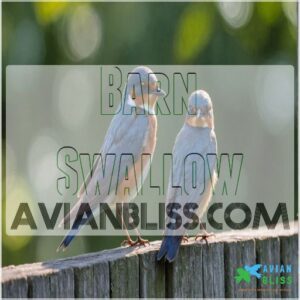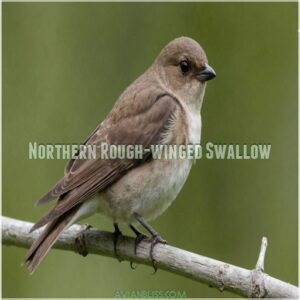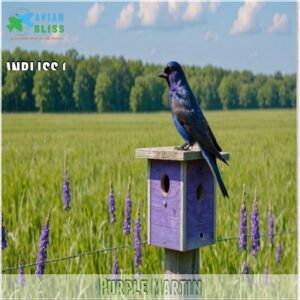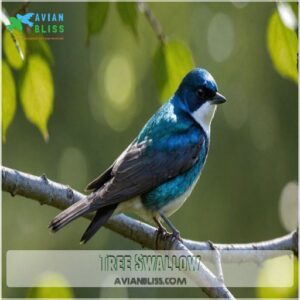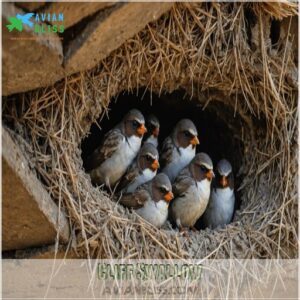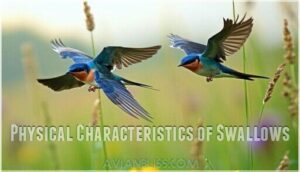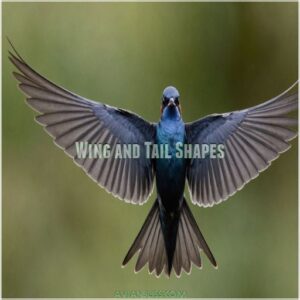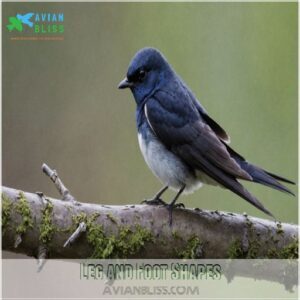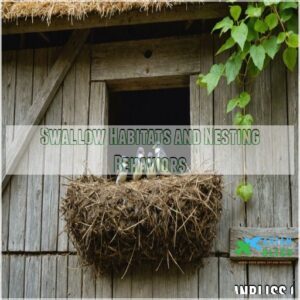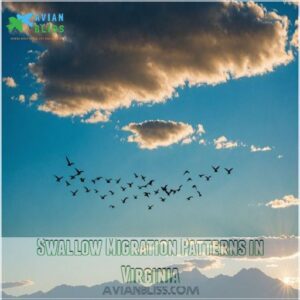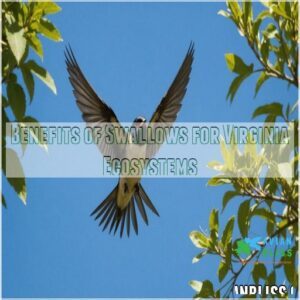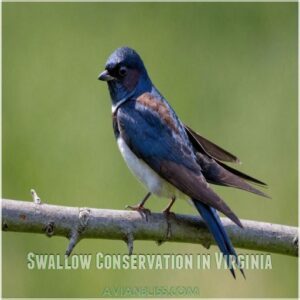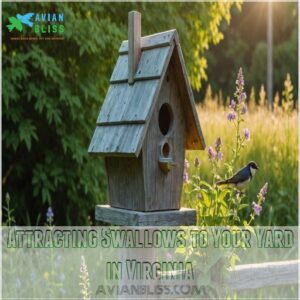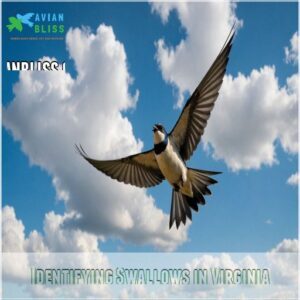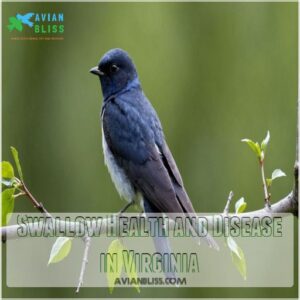This site is supported by our readers. We may earn a commission, at no cost to you, if you purchase through links.

With five main species—Barn, Northern Rough-winged, Purple Martin, Tree, Cliff, and Bank Swallows—each brings its own touch of elegance and utility to the ecosystem.
These birds help control the insect population, practically working as nature’s pest control squad.
Their habitats range from cozy barns to cliff sides, each species having its own preference.
Watching their swooping flight patterns might even inspire a sense of freedom.
Curious how these feathered friends affect their surroundings? The next stop will satisfy your thirst for nature’s wisdom!
Table Of Contents
- Key Takeaways
- Types of Swallows in Virginia
- Physical Characteristics of Swallows
- Swallow Habitats and Nesting Behaviors
- Swallow Migration Patterns in Virginia
- Benefits of Swallows for Virginia Ecosystems
- Swallow Conservation in Virginia
- Attracting Swallows to Your Yard in Virginia
- Identifying Swallows in Virginia
- Swallow Behavior and Social Structure
- Swallow Health and Disease in Virginia
- Frequently Asked Questions (FAQs)
- How do you identify a swallow?
- Are swallows good to have around your house?
- Are swallows a nuisance?
- How do you tell the difference between a male and female barn swallow?
- What do swallows eat in Virginia?
- How can I photograph swallows effectively?
- Are swallows affected by climate change?
- What are the predators of swallows in Virginia?
- How long do swallows live in the wild?
- Conclusion
Key Takeaways
- You’ll find six swallow species in Virginia, each with unique characteristics and habitats.
- These birds are beneficial, acting as natural pest control and pollinators.
- Swallows face threats like habitat loss and pesticide use, necessitating conservation efforts.
- You can attract swallows to your yard by providing food, water, nesting sites, and reducing pesticide use.
Types of Swallows in Virginia
When exploring the types of swallows you might encounter in Virginia, you’ll meet lively species like the Barn Swallow and cheerful Purple Martin.
These winged acrobats brighten your day with their colorful plumage but also play key roles in controlling insect populations.
Barn Swallow
The Barn Swallow, a common Virginia Swallow Species, is easily identified by its distinctive markings.
You’ll spot its iridescent blue back and vibrant reddish-orange chest.
Barn Swallows are fascinating creatures!
- Their diet consists mainly of flying insects.
- Sadly, nest parasites sometimes threaten breeding success.
- Current population trends are a concern, highlighting conservation threats.
Northern Rough-winged Swallow
Spotting the Northern Rough-winged Swallow isn’t tough with its plain brown back and soft buff underside.
This bird, a cavity nester, often borrows old burrows for its home.
As a summer visitor in Virginia, it thrives on insects.
Its soft buzz mightn’t win a Grammy, but it keeps nature’s rhythm alive.
Here’s a quick glance:
| Feature | Detail |
|---|---|
| Color | Light brown upper, buff white belly |
| Nesting Preference | Burrow former cavity nester |
| Vocalization | Soft buzzing notes |
| Conservation | Common, stable population |
Purple Martin
Ever wondered why Purple Martins are so popular among bird enthusiasts?
Known as the largest North American swallow, they’ve got a penchant for nesting in your backyard, often near water as is typical of their favorite habitats and characteristics.
Providing the right conditions, such as the ones mentioned, like nest boxes can help combat their population decline.
Conservation efforts focus on preserving their swallow habitat and ensuring these delightful birds stick around.
Tree Swallow
Shifting from Purple Martins’ robust calls to the gentle chatter of Tree Swallows, you’re in for a treat.
These iridescent beauties, with their greenish-blue sheen, happily occupy nest boxes.
Don’t be surprised if you hear their soft, warbling sounds.
Focused on conserving energy, they migrate deftly, following waterways.
Understanding Tree Swallow habitats helps guarantee these graceful creatures continue enchanting generations.
Cliff Swallow
You might appreciate how Cliff Swallows, stepping away from the Tree Swallow’s perch, create fascinating mud nests under bridges or cliffs.
Their social structure resembles a bustling neighborhood, each cliffside a suburb.
Foraging in groups, they feast on flying insects, timing their migrations to match the insect hatchings.
This swallow species brings unique flair to Virginia’s avian tapestry.
Bank Swallow
Imagine this: the nimble Bank Swallow flits through Virginia’s skies, amazing any onlooker.
With a distinctive habit, they carve out nest burrows in sandbanks.
Here’s what might pique your curiosity:
- Their diet includes insects caught mid-flight.
- They thrive in large colony sizes.
- Ever wondered their migration routes?
- Currently, their conservation status is stable.
Physical Characteristics of Swallows
When you examine swallows in Virginia, you’ll notice their vibrant color patterns and sleek wing shapes that distinguish them in the sky.
Their relatively short bills are perfect for snatching insects mid-flight, while their agile tail feathers guarantee swift, graceful maneuvers that could make even the most agile dancer envious.
Color Patterns
Now that we’ve met some Virginia swallows, let’s talk about their looks!
Swallow color variations are fascinating.
Think of the Barn Swallow’s rusty red chest and blue back—a real head-turner!
Plumage differences exist between males and females, and even change seasonally.
Geographic variations in swallow color also occur.
For example, breeding plumage often boasts brighter colors.
These color patterns are key for swallow identification.
Spotting these differences helps you appreciate the incredible diversity within swallow species and their range.
Wing and Tail Shapes
Swallows’ wing and tail shapes are marvels of nature, helping with flight maneuverability and rapid twists mid-air.
Wing shape adaptations contribute to sleek gliding, while the forked tail functions like a rudder.
Tail feather variations aid in precision during acrobatic flights.
These features differ among swallow species, making identification fun and insightful, especially when observing their behavior and migration patterns.
Bill Shapes and Sizes
Ever wondered why swallows have different bill shapes and sizes?
It’s all about survival and snacking preferences.
With bill shape variations adapted to catch insects mid-flight, these adaptations are important.
The slender bills—evolved for efficiency—allow quick captures of tiny prey.
So next time you’re birdwatching in Virginia, notice how these sleek designs help swallows thrive and satisfy their dietary needs.
Leg and Foot Shapes
While swallow bills adeptly catch insects mid-air, their leg and foot structures make them masters of perching.
- Foot size and weight: Designed for lightness.
- Claw shape and function: Ideal for gripping branches.
- Adaptations for perching: Feet perfectly adapted for stability.
- Differences between species: Each has unique adaptations.
- Perfect for bird identification: These traits aid in recognition.
Swallow Habitats and Nesting Behaviors
Swallows in Virginia are fascinating architects, crafting nests with impressive ingenuity in diverse habitats such as cliffs, barns, and even urban areas.
You’ll find their colonies or solitary nests showcasing innovative use of grasses and mud, hinting at their resourceful nature and preference for different nesting sites.
Preferred Nesting Sites
You might ponder how these swift, colorful creatures choose their homes.
Nest site selection reflects their need for both safety and convenience.
Swallows often prefer human-made structures, natural cavities, and even custom nest boxes.
Here, they thrive, adhering to their natural cavity requirements while embracing their swallow range and distribution.
| Structure Type | Commonality | Emotional Note |
|---|---|---|
| Human-Made | Frequent | Unlikely allies |
| Natural Cavities | Classic | Cozy and familiar |
| Nest Boxes | Novel | Humanity’s gesture |
Nest Construction
Swallow nests are nature’s marvels, built with mud, twigs, and grasses.
These skilled architects choose nest locations wisely, balancing size and defense against nest predators.
Similarly, plumbers must consider the intricacies of plumbing code guidelines, like water pipe sizing and fixture requirements, to make sure safe and functional systems.
Nest maintenance is important as it supports swallow breeding and behavior.
In Virginia, understanding swallow habitat
Colonial Vs. Solitary Nesters
After building their nests, some swallows are social butterflies, nesting in large colonies. Others prefer a more solitary life, each couple claiming its own territory.
Colony living offers advantages like shared predator defense, but also means increased nesting site competition. It’s worth noting that colony size impacts nesting success rates, with smaller colonies sometimes faring better. Think of it like a family reunion – sometimes, less is more!
Social hierarchy plays a role in colony dynamics.
Nesting Materials
Imagine swallows busily gathering mud, grasses, and feathers to create their perfect nest.
This careful blend caters to their nest preferences, ensuring a sturdy home.
In Virginia, the materials’ availability greatly influences nest site suitability.
Human impact can disturb this delicate process, making conservation essential.
Whether birdwatching or aiding nest maintenance, understanding swallow nesting brings you closer to these fascinating creatures.
Swallow Migration Patterns in Virginia
You’ll find that swallows in Virginia are precise timekeepers, arriving in early spring and departing by late fall, putting your punctuality to shame.
These aerial acrobats navigate vast migration routes to wintering grounds in Central and South America, making brief pit stops along the way.
Arrival and Departure Times
A well-timed spectacle, swallow migration in Virginia delights bird watchers with its punctuality. Watch for these timing trends: For more information on small birds in Virginia, including their habitats and migration patterns, see bird migration patterns.
- Arrival patterns: Most swallows touch down in April.
- Peak migration: May through June sees peak numbers.
- Seasonal variations: S
Migration Routes
As these agile aerial acrobats leave Virginia’s skies, they set off on epic journeys.
Routes vary, with each flock using instinct to navigate shifting winds and landscapes.
Stopover locations become resting places where they refuel before continuing.
You’ll notice changes in migration timing and altitude due to climate impacts.
Observing these Virginia birds during migration reveals fascinating swallow distribution patterns.
Wintering Grounds
Imagine this: swallows set off on epic journeys, moving to wintering grounds far from Virginia, often in South America.
This round trip is risky, with challenges like habitat loss and climate change reshaping migration routes.
Conservation efforts help protect these Virginia birds.
Observing swallow behavior and distribution patterns provides insights into these fascinating creatures as they adventure through ever-changing skies.
Stopover Sites
You’ve probably noticed swallows darting through Virginia’s skies; they’re passing through critical stopover sites.
These locations offer rest and refueling during migration, making their preservation essential.
Sadly, threats like urban development put these sites at risk.
Ongoing stopover site research and management are essential to protecting these fascinating travelers and ensuring more delightful swallow sightings for birdwatchers enjoying birding in Virginia.
Benefits of Swallows for Virginia Ecosystems
You’ll find that swallows are incredibly beneficial to Virginia’s ecosystems; they’re natural pest controllers, gobbling up countless insects, and their presence acts as a great indicator of a healthy environment.
Think of them as tiny, winged guardians of our natural spaces, keeping insect populations in check and contributing to a balanced ecosystem.
Insect Control
While swallows gracefully navigate Virginia’s skies during migration, they also serve as nature’s pest control.
Their swallow diet includes tons of flying insects, like mosquitoes and beetles, acting as natural pesticides.
This swallow impact reduces the need for chemical pest control.
You might say they’re the unsung heroes of insect control, keeping the balance in Virginia.
This is especially beneficial when paired with targeted insect control methods.
Pollination
After controlling insects, swallows provide another unexpected boost to ecosystems: pollination.
Their nests support many pollinating insects like bees, enhancing plant diversity by spreading pollen from nectar sources.
This activity helps combat pollinator decline, ensuring the survival of native plants and boosting the overall swallow impact on Virginia habitats.
So, swallows aren’t just winged insect vacuums; they’re key Virginia birds aiding conservation.
Ecological Indicators
Swallows act as storytellers of the ecosystem, revealing shifts in habitat changes and climate impact.
By observing swallow populations, you can catch early signals of environmental shifts.
These Virginia birds thrive in healthy habitats, making their abundance a sign of ecological well-being.
Their lively antics are both charming and helpful in guiding bird conservation efforts, essential in combating pesticide effects.
Ecosystem Services
You’re probably aware that ecological indicators highlight ecosystem balance.
Now, let’s chat about swallows and their stellar ecosystem services.
These Virginia birds swoop in for pest control, munching on insects and balancing the food web.
By promoting biodiversity, swallows play an unsung role in bird conservation and improving bird habitats, which reduces habitat loss.
Isn’t nature’s teamwork impressive?
Swallow Conservation in Virginia
You’ll find that swallow conservation in Virginia is important, as these birds face threats like habitat loss and pesticide exposure.
By supporting habitat preservation and other conservation efforts, you can help guarantee their survival and enjoy their aerial acrobatics for years to come.
Threats to Swallow Populations
You might love seeing swallows darting through the sky, but they’re facing some tough challenges.
Habitat loss, pesticide use, climate change, and disease outbreaks are taking a toll on their populations.
Additionally, collisions with windows are another significant threat to swallow populations, highlighting the need for bird-friendly habitats.
With rising competition for resources, these threats to swallows require your attention.
Think of swallows as the canaries in
Conservation Efforts
Because of threats like habitat loss and pesticide use, swallow conservation in Virginia is essential.
Protecting these amazing Virginia birds requires a multi-pronged approach.
Here’s what you can do:
- Support organizations dedicated to swallow conservation.
- Minimize pesticide use in your yard.
- Educate others about the importance of swallow conservation.
Habitat Preservation
Following the conservation strides, habitat preservation is your next call to action.
Swallow populations in Virginia face a pinch due to urban sprawl and habitat loss.
By supporting conservation strategies, and reducing pesticide impact, you help guarantee these Virginia birds continue enchanting our skies.
Whether through observing their antics or aiding swallow conservation, every little bit counts for habitat preservation!
How to Attract Swallows to Your Property
Enticing swallows to your property isn’t a tall order.
Start by installing swallow houses or nest boxes, which are like luxury condos for them.
Add native plants for shelter and a diverse buffet of insects.
Include a water feature, ensuring a splash zone they’ll love.
With these steps, you’ll soon enjoy the lively antics of backyard birdwatching in Virginia.
Attracting Swallows to Your Yard in Virginia
To attract swallows to your yard in Virginia, offer food and water, create nesting sites, and plant native vegetation.
Reducing pesticide use helps invite these graceful aerial acrobats but also keeps your garden buzzing with life.
Providing Food and Water
Attract more swallows to your Virginia yard effortlessly by offering food and water.
Swallows thrive when you focus on their needs.
Consider these tips:
- Feeders: Use specialized feeders ideal for swallow diets.
- Natural food sources: Grow plants to attract insects.
- Water quality: Keep water sources fresh and clean.
- Seasonal food: Adjust feeding according to Virginia birds by season.
Creating Nesting Sites
To create welcoming nesting sites, pick a quiet spot in your yard and mount a sturdy nest box.
Use durable materials like wood and make sure the box has proper ventilation.
Placement matters—choose areas away from predators and harsh weather.
Regularly check and clean the boxes for maintenance. This way, swallows and other Virginia birds will feel right at home, adding lively activity to your backyard.
Planting Native Vegetation
After setting up ideal nesting spots, imagine enhancing your backyard by planting native vegetation.
It’s like throwing a welcome mat in the wild for swallows in Virginia.
Embrace backyard habitat restoration through native plant benefits and enjoy watching these Virginia birds flourish.
- Opt for plants like Eastern Red Cedar.
- Cater to natural food sources.
- Support local nurseries.
- Encourage Virginia wildlife.
Reducing Pesticide Use
Want swallows flitting around your Virginia yard? Think twice before reaching for pesticides. Pesticide impacts on Virginia birds, including swallows, are significant.
Instead, embrace Organic Alternatives and Natural Pest Control. Sustainable Gardening practices, like using beneficial insects, will keep pests at bay naturally. Bird-Friendly Practices mean a happy, healthy ecosystem—and more swallows! It’s a win-win for you and Virginia wildlife.
Identifying Swallows in Virginia
You’ll become an expert at identifying swallows in Virginia by keeping an eye on their flight patterns and distinctive plumage.
Using field guides and tuning in to their unique calls can make the experience as enjoyable as a birdwatching adventure with friends.
Using Field Guides
You’re all set with your yard to welcome swallows, but how do you know who’s visiting?
Snag a field guide for fun bird identification!
These handy books offer:
- Visual Cues: Quickly spot swallows with detailed images.
- Key Features: Look closely at unique markings.
- Accurate Identification: Make sure you’re identifying Virginia birds correctly.
Enjoy the thrill of Virginia birding!
Observing Flight Patterns
Spotting swallows in Virginia is a joyride for bird enthusiasts!
Notice their flight speed and wingbeat frequency.
Swallows’ aerial acrobatics and dive patterns offer cues for bird identification.
Watch for their soaring behavior—Barn Swallows dart swiftly, while Purple Martins glide smoothly.
Grab your binoculars and start swallow observation; bird watching in Virginia is like witnessing nature’s air show.
Noticing Plumage Differences
When you’re in Virginia, noticing plumage differences among swallows can be a joyful journey.
Barn Swallows boast iridescent blues, while Purple Martins dazzle with their dark, shiny tones.
Seasonal changes reveal age differences, with immature birds showing duller shades.
Look for sex-specific markings, like light underparts in female Tree Swallows, for precise bird identification amidst the diverse Virginia birds.
Listening to Calls and Songs
Tuning in to swallow vocalizations in Virginia is like eavesdropping on nature’s symphony.
You’ll identify swallows by:
- Chirps and calls of Barn Swallows, sounding like liquid twittering.
- Northern Rough-winged Swallow’s dry, single-note calls.
- Purple Martin’s rich, bubbly songs.
- Cliff Swallow’s chattering chat.
Listening teaches sound identification and song variations, enriching your bird identification skills.
Swallow Behavior and Social Structure
You’ll find that swallows in Virginia are social birds with intriguing behaviors, often seen flocking together in large groups to hunt insects or defend their territories.
Swallows in Virginia are social birds with intriguing behaviors, often seen flocking together in large groups to hunt insects or defend their territories.
Their mating rituals and cooperative parenting strategies are fascinating to observe, blending teamwork with a touch of competitive flair.
Flocking Behavior
Hundreds of swallows gather in impressive flocks before migration.
You’ll see these amazing flock formations, impacting their foraging strategies and boosting predator avoidance.
Flocking size varies depending on the species and time of year.
These aerial acrobatics are a sight to behold, a strong indicator of their incredible social structure.
Observing their migration timing helps you appreciate their journey.
Understanding Virginia birds’ flocking behavior enhances your bird identification skills.
Mating and Breeding Habits
Swallows in Virginia engage in fascinating mating rituals, often showcasing graceful aerial displays to attract a mate, similar to the extended courtship displays of the Northern Rough-winged Swallows.
These birds prioritize selecting the best nest sites during the breeding season for ideal safety.
A typical brood size ranges from three to six eggs, ensuring a lively little family.
Remember, swallows are social Virginia birds, adding charm and excitement
Parenting and Nesting Behavior
Just after finding the right mate, swallows in Virginia get busy with parenting and nesting.
They choose nest sites carefully, often under eaves or ledges, balancing ease of chick feeding with nest defense against brood parasitism.
Parental care is impressive, with both partners feeding the chicks, ensuring these backyard birds in Virginia thrive and flutter freely.
Agonistic Behavior
Caring for swallow chicks often leads to fascinating territorial disputes.
Agonistic behavior among Virginia birds like swallows involves:
- Dominance hierarchies: Some establish order through displays and pecking.
- Nest defense: Fiercely protective parents fend off intruders.
- Food competition: Birds vie for insects, each claiming their share.
These swallow facts highlight competitive streaks in their social structure.
Swallow Health and Disease in Virginia
When you’re observing Virginia’s swallows, it’s important to keep an eye on their health, as these birds face challenges from diseases and parasites.
Climate change and human interactions also impact their well-being, making research and monitoring efforts essential to guarantee these feathered acrobats continue to grace our skies.
Common Diseases and Parasites
In Virginia, swallows face challenges from diseases and parasites, which can quickly spread in their colonies.
Using proper Virginia bird supplies can help reduce disease transmission.
These health issues impact bird species like the Barn Swallow and Purple Martin.
Regular monitoring helps identify disease spread early.
You can protect swallows by reducing pesticide use and supporting treatment options.
It’s important for maintaining healthy Virginia bird populations and
Impact of Climate Change
With shifting seasons and rising temperatures, climate change affects swallow health in Virginia.
You’re noticing:
- Swallow range shifts: Birds venture beyond typical territories.
- Population decline: Less food availability leads to fewer birds, much like the Barn Swallows’ insect intake decline skilled aerial insectivores, which consume hundreds of mosquitoes daily.
- Migration timing: Changes disrupt breeding cycles.
Human-Swallow Conflicts
Climate change isn’t the only challenge swallows face.
Sometimes, you might find yourself in a bit of a standoff with these beneficial birds.
Let’s look at some common conflicts:
| Conflict Type | Example | Solution |
|---|---|---|
| Swallow-related damage | Messy nests under eaves | Install nest deflectors |
| Food competition | Swallows eating your garden insects | Plant extra for both of you |
| Safety concerns | Birds near power lines | Trim vegetation near power lines |
Remember, these awesome Virginia birds help control pests!
Finding solutions that benefit both you and the swallows is key.
Research and Monitoring Efforts
Swallows’ presence in your yard might stir a few feathers, but research can help a lot! You can engage in citizen science and aid in data analysis to uncover intriguing population trends.
Here’s how to get involved:
- Join local birdwatching groups.
- Participate in swallow research projects.
- Monitor long-term changes in Virginia birds like Barn and Northern Rough-winged Swallows.
Frequently Asked Questions (FAQs)
How do you identify a swallow?
Spot a swallow by its sleek body, pointed wings, and forked tail.
Look for iridescent or earthy tones in plumage.
Watch it soar gracefully, often near water or open areas, catching insects mid-flight.
Are swallows good to have around your house?
Having swallows near your home is beneficial because they eat bothersome insects, acting as natural pest control.
Their charming aerial acrobatics add lively entertainment to your yard, though their nests may require occasional cleaning up.
Are swallows a nuisance?
You might find swallows a bit of a nuisance if their nesting habits leave droppings or debris around your home.
However, their insect-eating skills help control pests, which can make them welcome neighbors instead.
How do you tell the difference between a male and female barn swallow?
Barn swallows’ plumage offers clues.
Males boast vibrant chestnut throats and foreheads; females’ are more subdued.
A longer, more deeply forked tail also hints at a male.
It’s a subtle difference, but practice makes perfect!
What do swallows eat in Virginia?
Swallows in Virginia primarily feast on flying insects like flies, beetles, and moths, catching them mid-air with remarkable agility.
Picture a tiny aerial acrobat executing daring moves to nab its tasty buggy meal, right?
How can I photograph swallows effectively?
Capturing swallows in action requires patience and practice.
Use a fast shutter speed to freeze their swift flight.
Aim for early morning or late afternoon light for softness.
Keep a telephoto lens handy to catch those distant shots.
Are swallows affected by climate change?
Over 80% of bird species, including swallows, show altered migration patterns due to climate change.
You can help by preserving habitats and reducing carbon footprints.
Swallows face habitat shifts that affect breeding and food availability.
What are the predators of swallows in Virginia?
Imagine swallows dodging hawks, owls, and even snakes.
In Virginia, these agile birds face predators like falcons, crows, and domestic cats, which can target eggs or nestlings.
Nature’s balancing act keeps them on high alert!
How long do swallows live in the wild?
In the wild, swallows typically live for about four to six years.
However, some can beat the odds and reach up to eight years, making the skies their playground for a surprisingly long time.
Conclusion
Swallows in Virginia showcase swooping spectacles and stunning survival skills, offering insights into vibrant ecosystems.
With their multiple species, they provide pest control and pollination, enhancing ecological balance.
Observing their agile aerobatics offers both joy and understanding of nature’s interconnected web.
As you welcome these winged wonders into your life, consider their contribution to creating a healthier habitat.
Whether you’re drawn to their dynamic displays or dedicated to conservation, these birds greatly enrich Virginia’s natural tapestry.

